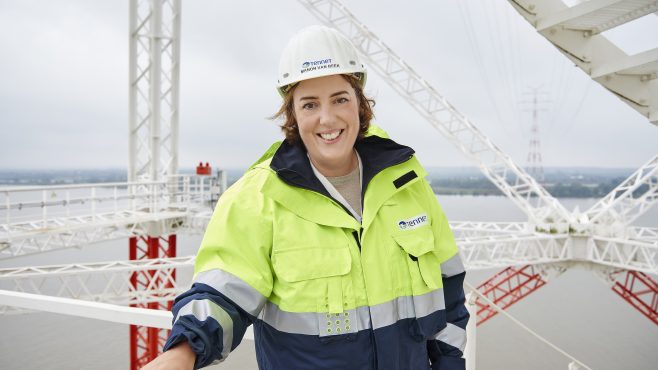On 10 June 2021, a partial solar eclipse knocked out solar power in the Netherlands, equivalent to a little more than the consumption of Amsterdam. “But of course we were prepared and kept the grid stable,” says Manon van Beek, CEO of Dutch national grid operator Tennet, which also runs a large part of the German grid. In conversation with Energy Monitor, she discusses the challenge of meeting European climate targets while keeping the lights on.

2020 was a good year for Tennet. Despite Covid-19, the company set records for investment (€3.4bn/$4.12bn), security of supply (99.9999%), recruitment – notably from the struggling entertainment industry and airlines – and green financing (green bond issuance).
What does the EU’s higher 55% emission reduction target for 2030 – and 65% in Germany – mean for you as a grid operator?
If we want to meet these targets, we need to speed up what we are doing three to four times. When I joined Tennet three years ago, I was proud to join a company with an investment agenda of €3–4bn a year. Now we are talking about €5–6bn a year for the next ten years.
We are not up to speed yet, either in the industry, in the European institutions or in national politics. We need more than targets and ambition. We need a clear road map. At Tennet we understand the electricity system. My obligation as CEO is to follow our electricity laws and flag what is feasible and what is not for 2030. And if not feasible, to come up with alternatives.
People talk about 2030 and say we have nine more years. I say we have one more year. Our projects typically take eight to ten years, most of which is planning and licensing.
At the end of April, we published our infrastructure outlook for 2030–50. It focuses on the Netherlands – indeed it is part of the Dutch climate agreement – but its insights are broader. Together with Dutch DSOs [distribution system operators] and Gasunie, the Dutch gas TSO [transmission system operator], we explored the future energy system bottom-up. We concluded that although things seem uncertain, in every scenario for climate neutrality by 2050 we will have to double electrification, we will need hydrogen, there is some form of carbon capture and storage (CCS) and we need flexibility, in demand and supply.
What political decisions do you need to get on track for 2030?
We need to know what should be in place by when. We need political decisions about where solar and wind power will be generated, where electricity will be converted into hydrogen and where we will have storage. I can envisage a big solar park close to a data centre, preferably with a battery next to it – but we need the right incentives to get it built.
The [Dutch] government can already make some no-regret decisions, such as kicking off the development of a hydrogen “backbone" [network]. Hydrogen is crucial to Tennet because it can deliver additional capacities for decarbonisation, energy transport and storage.
There will be increased demand for transporting and storing energy. We cannot bet only on electricity grids. It can be five to ten times cheaper to transport energy in the form of molecules when final consumption is foreseen in this form. We are in favour of building or converting gas grids into a hydrogen backbone. Electrons and molecules are friends. We need it all for the energy transition.
What are your plans for the North Sea?
We believe a more international meshed offshore grid [rather than point-to-point connections] can deliver huge efficiency gains. After 2030, we envisage more of a hub-and-spoke system, where we collect power from a multitude of offshore wind farms and connect to several countries.
A good example is the Wind Connector project we are working on with National Grid Ventures from the UK. We want to connect [4GW of] Dutch and British offshore wind to both country’s energy systems, and grow interconnection capacity between them by 2GW. This is the first such project for the Netherlands and the UK.
[Keep up with Energy Monitor: Subscribe to our weekly newsletter]
We are also part of the North Sea Wind Power Hub consortium, with Gasunie and Energinet [Denmark’s combined gas and electricity transmission system operator] to explore the shift to a hub-and-spoke model and the respective role of electrons and molecules [hydrogen, to transport and store the power produced] within that.
The North Sea will become the powerhouse of Europe. If we want to see cross-border grids and wind farms at scale in it, we need a clear investment case for such international projects and we need to make sure EU rules are not a showstopper.
How could European rules become a showstopper?
A prominent example is the 70% rule on grid capacity, which was not made for offshore grids and risks hindering their development, as Danish MEP Morten Helveg Petersen said at our ‘Fit for 55’ event with [European Commission Vice-President in charge of the European Green Deal] Frans Timmermans on 1 June.
The 70% rule on grid capacity was not made for offshore grids and risks hindering their development.
The problem is if you have a wind farm in the North Sea, for example, connected to Denmark and the Netherlands, the rule obliges the TSO to set aside 70% of that line for international trade. This means the wind farm owner does not know whether he will always be able to transport his product to shore. There may be moments when he cannot sell.
The EU institutions should also study how this rule influences the CO2 intensity of electricity production. CO2 is becoming the currency of European energy policies. What matters is not the impact of an individual project, but the impact of that project on the system.
On 1 June, you said it was important to anchor the placement of electrolysers [for green hydrogen production] in European law. Why?
It makes a huge difference to the total cost of the energy system whether you put an electrolyser 100km north or south of Hamburg [in Germany], for example. It is not enough to aim to put renewables and electrolysers in the same bidding [electricity price] zone.
In the Netherlands and Germany, electrolysers with a cumulative electrical load of 9GW are planned for 2030. That is seven times the peak load of Munich. It makes a huge difference where you put these loads. Electrolysis must not lead to the curtailment of renewable power because of insufficient transmission capacity.
We did some calculations. If you put electrolysers at a location far from renewables, that could cost, in the short term, several hundreds of millions of euros in extra operational costs to manage grid bottlenecks – and we are not yet talking about the need to have additional grids. That could easily cost several billions of euros.
If you run your electrolysers at the wrong time in the wrong place, you could also increase rather than decrease net CO2 emissions. If we have to switch on gas or coal power plants to feed electrolysers it does not help the climate.
A more granular approach to electrolyser incentives is needed in European law.
We need locational and operational incentives. One idea, which is slowly gaining traction, is that if you get state aid for an electrolyser, you should face financial impacts if you cause congestion. [The EU's state aid guidelines for energy and environment are currently being reviewed.]

Tennet is involved in two high-capacity north-south power lines that will be decisive for Germany – and Europe – to use more renewables. They have attracted a lot of local public opposition, however. Will SuedLink and SuedOstLink be ready on time?
They are both on track. At the end of May, we ordered, together with 50Hertz, the delivery of two converter stations for SuedOstLink, from Siemens. That is a very important milestone: we would only order them if we were on track to place them. It does not make sense to have them in storage.
SuedLink and SuedOstLink are key for the German and European energy transition. All stakeholders, including public authorities, are aiming to realise these high-voltage, direct current projects as soon as possible. They will be decisive in making it possible to bring renewable energy [from the North Sea] to customers.
What can be done to build public acceptance around such big projects?
On a European level, we will need environmental space for this energy transition and full political support. More and more we want to bring supply and demand together. We want to concentrate things. That is more efficient and will bring lower costs, but it will also make infrastructure more visible. Do we want energy hubs? Someone is [always] the neighbour of that battery, data centre and solar park.
Do we still need gas for security of supply?
I think so. If I take Germany, a 65% greenhouse gas emission reduction by 2030 would mean a total phase-out of coal much earlier than expected, by 2030 instead of 2038, and it is still an open question how that capacity will be replaced. It is the old question of what do we do when the wind does not blow and the sun does not shine.
The Greens in Germany, for example, are proposing 60GW of green gas-fuelled power plants. I think gas or green gas plants are needed. If we conclude that we need gas plants of some sort, we should make sure the EU taxonomy [for green investment] does not make them unnecessarily expensive.
We need to have this debate now. We cannot talk about a coal exit without broaching the question of how this capacity will be replaced. My job is to keep the lights on.
What opportunities do you see to balance the system with flexibility from distributed resources such as electric vehicles, via distribution system operators, and from the demand side?
We will massively electrify and will need all of these solutions and a hydrogen backbone. There is no such thing as average weather. We need to balance the grid every four seconds. I need to know what I am going to do in those rare but real periods when there is no sun or wind.
It is not just about expanding the grid, but using it better. We are making sure cables can cope with more heat so they can transport larger amounts of power. We are also working with big electric batteries called “grid boosters”. In future, these will hopefully provide the reserve margin we set aside on the grid today – in case an element suddenly drops out of circulation – so we can use the full capacity of our lines.
How has the role of the TSO changed and how does it look going forward?
Grids will be used in different ways in the future. In Europe, where we run one of the safest, most reliable networks in the world, the grid has become what you could call a multifunctional connector of energy supply, demand and storage.
In my flexible working space in Arnhem [the Netherlands] I have a three-part balance scale, where each part represents sustainability, reliability and affordability. When people wait for me ahead of a meeting, they try to balance them and it is really hard. That is our job. Last year was a record year for security of supply, but that should not be taken for granted. Look at the impact of the partial solar eclipse. We are changing the system from something that is certain to something that is sustainable but weather dependent.



